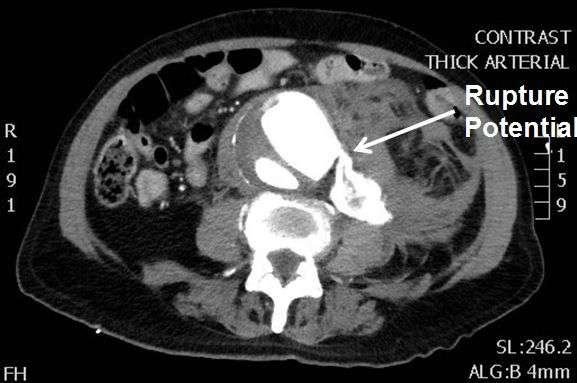Algorithm predicts artery rupture

WA scientists have developed a cheap test to predict if a patient will suffer a ruptured abdominal aortic aneurysm—a deadly condition where the blood pressure inside a weakened artery causes it to suddenly burst.
Aneurysms are permanent, mainly symptomless and develop when part of a blood vessel swells like a balloon.
The condition can cause sudden death from severe internal bleeding.
Doctors use medical imaging to locate and measure aneurysms, but they are unable to detect when a vessel has reached bursting point.
University of Western Australia biomechanic Dr Grand Joldes says his team developed an algorithm to quickly map the amount of stress, or tension, on an artery wall.
"It is an extremely simple simulation for computing wall tension in abdominal aortic aneurysms," Dr Joldes says.
"Until now, there are no methods that can give you, in high certainty, an indication if the aneurysm will rupture or not, and so it is very difficult to make clinical decisions whether to operate or not," Dr Joldes says.
He says by measuring the deformed artery's geometry and applying existing computer algorithms, the scientists can model stress distribution without needing to know tissue properties, which vary greatly between patients.
"By comparing the stress in the wall with the wall strength, determined from population studies, one can assess the rupture potential," Dr Joldes says.
"The outcome of the computation is a map of the stresses on the artery wall."

While doctors normally study stress in aneurysms by examining images of the vessel and considering what it would look like not under pressure, the research team took the opposite approach.
"If you know the deformed configuration and the load, then the stress distribution depends very weakly on the undeformed configuration and the material properties," he says.
"This happens because the stress in the wall has to balance the external forces that are applied and therefore there needs an equilibrium between the external forces and the stresses."
The UWA team, whose work is published in the Journal of the Mechanical Behavior of Biomedical Materials, says the calculations can be performed quickly within a clinic, using simple computer hardware.
While the researchers focused on abdominal aortic aneurysms in this study, they say the measurements can be used to calculate stress loads in other parts of the body.
Dr Joldes says stress computing is undergoing patient trials to investigate their effectiveness at predicting aneurysm ruptures.
This article first appeared on ScienceNetwork Western Australia a science news website based at Scitech.


















